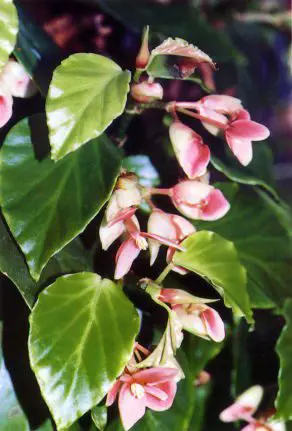This group of begonias is small, consisting of about 35 species and 35 cultivars to date. The name is taken from their growth habit, “trailing” meaning to grow to some length over the ground, and scandent meaning climbing. They grow somewhat like vines.
One would think from the word meanings that this group are only trailers, but this is not so. They usually have many branches and send up basal shoots, thus lending themselves superbly to hanging baskets or to being trained up posts, a trellis, or totem poles. Stems can grow eight feet or more, while their thickness is quite varied and the internodes are quite long.
Leaf sizes and shapes can be quite varied also, while the texture/surface can be glabrous, hairy, puckered, or pustulate. Most are packed with small leaves and bloom in clusters, more or less profusely, the flowering season varying from plant to plant.
The first species in this group to be discovered, B. glabra, was found in the West Indies in 1775. Brazil is the country of origin of Begonias fagifolia (1836), radicans (1831), and the beautiful fragrant solananthera (1859). B. mannii was discovered in 1862 at an elevation of 1300 feet on the peak of Fernando Po, an island off the coast of West Africa.
These begonias are good subjects to grow hanging from tree limbs. Plenty of light is a must; they will even take some sunlight, but not midday sun. Good light will help produce a full plant with lots of bloom. If leaf stems elongate, and the space between the joints gets longer, you know the plant wants more light. If the foliage pales, the plant is getting too much light.
Potting is more crucial than for some other begonias, because the long pendulous stems are fragile. If you use plastic pots be careful not to overwater. A shallow container is best, because these begonias are shallow rooted. Do not overpot. Only pot up one size larger than the present pot. Too much extra space can produce weak plants and retain too much water, the result being a “drowned” plant.
Soil pH should fall within the 5 to 6.5 range. Use a reasonably open mix, so as to get good drainage. A good rule is to water only when the potting mix feels dry to the touch; but if the weather is hot or the plant seems to dry out faster because it is in a hanging basket, water more often.
Staking is not necessary, but pruning and pinching can make the difference between a “so-so” plant and a great one. Prune out the old stems and long bare sections. Pinch stems often to encourage branching and to obtain stems of varying lengths, resulting in a shapely plant. A good rule is to cut back the stems of those with long internodes after the 3rd node; those with shorter internodes after the 4th or 5th.
When flowering time is nearing, leave the tips to produce and develop the buds. A complete fertilizer used throughout the active growing season should be supplemented just before and during the flowering season with a high phosphorus food.
Trailing-scandent begonias can be propagated easily using stem cuttings, especially tip cuttings you create when you pinch and prune. Check the Seed Fund list and try growing some trailing-scandent begonias from seed. Remember that seed from species will produce plants true to the parent plant.
I have over twenty varieties of the trailing scandent begonias. Some I have growing are:
B. solananthera, noted for its powerful spicy fragrance, begins blooming in mid-winter with red- centered white flowers against heart-shaped apple-green foliage.
B. ‘Marjorie Daw’ was one of the earliest hybrids – 1898 – its parents being B. coccinea x B. radicans.
B. fagifolia is a species from Brazil with white flowers in spring. It has hairy leaves and a wonderful zig-zag stem – try training it on a totem pole.
B. ‘Bob-O-Link’, hybridized in 1949 (B. radicans x B. ‘Richard the First’), has light rose-red flowers and is everblooming.
B. radicans, with profuse deep coral flowers in early spring, has graceful branching stems. Sometimes referred to as the “shrimp” Begonia, it has also gone under the names procumbens, glaucophylla, limminghei, limmingheana, even coccinea.
B. ‘Splotches’, hybridized in 1978 (B. solananthera x B. radicans) has pink and cream splotches on an apple-green leaf. Flowers are pink, edged in white.
B. loranthoides ssp. rhopalocarpa, discovered in 1895 in Cameroon, a country on the western coast of Central Africa.
B. ‘Yorke’s Nocturne’ a Queensland hybrid and growing very profusely, has glossy pustulated leaves edged in the finest red/brown, cluster of white flowers.
B. ‘Glenata’, another Queensland hybrid by Bernard Yorke, is again a sprawling, profuse plant. Flowers are white.
B. ‘Serinata’, again a Bernard Yorke hybrid, beautifully shaped leaves. It should come along well on a totem or up a wall.


